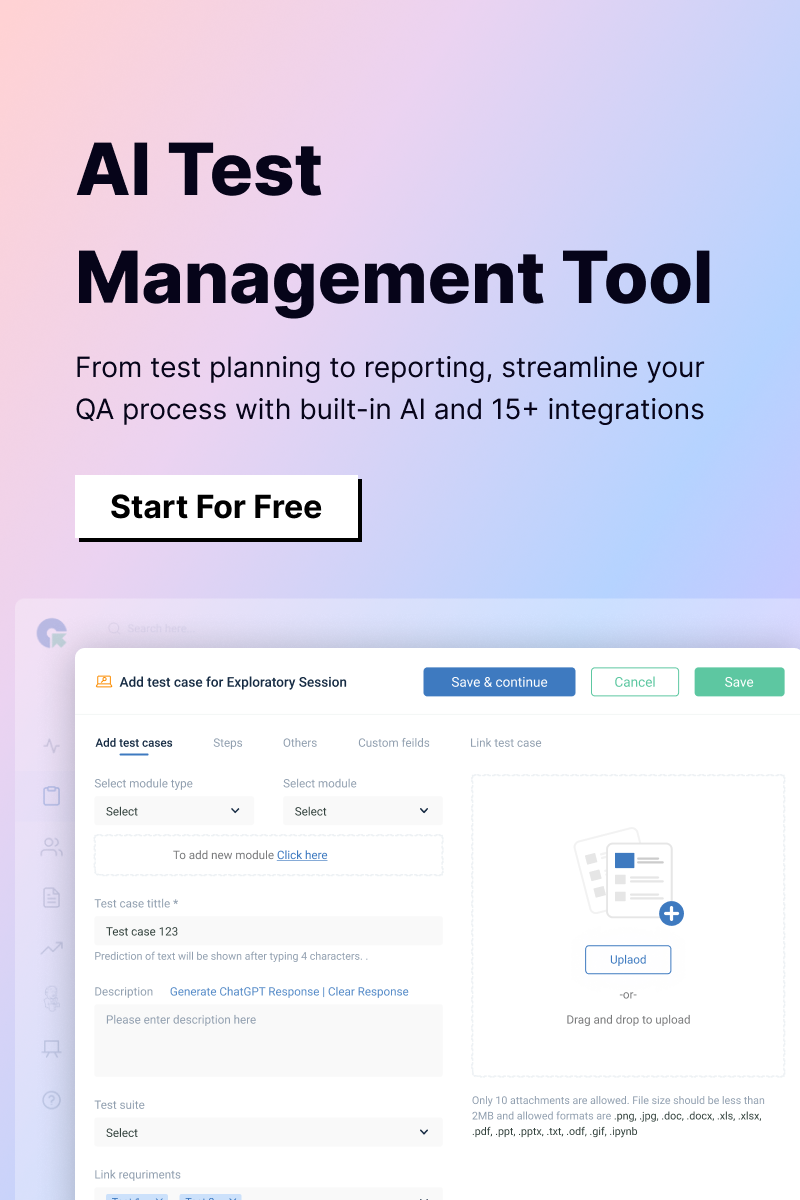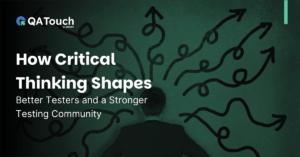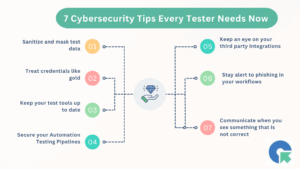For QA testers, leads, and managers, writing effective test cases is one of the most critical steps in delivering quality software. Test cases ensure that requirements are thoroughly validated, expected behaviors are verified, and defects are uncovered before release.
Yet, traditional test case authoring has long been a challenge. Creating test cases manually is slow, subjective, and prone to gaps. Even experienced testers can miss edge cases or spend too much time documenting instead of testing.
Today, Generative AI (GenAI) is transforming this process. GenAI can automatically generate meaningful, detailed test cases from your existing inputs, whether they are user stories, UI images, or JIRA tickets, helping QA teams improve efficiency, coverage, and consistency. In this blog, we will explore the evolution of test case authoring, the workings of GenAI, its use cases, benefits, challenges, and more.
The Evolution of Test Case Authoring
Over time, test case authoring has gradually changed to become more efficient and streamlined. What was once a fully manual task has seen steady improvements through automation and smarter tools, and now, Generative AI (GenAI) is helping take this evolution a step further.
From Manual to Automated Test Case Creation
In the past, test cases were traditionally written by hand, requiring significant time and effort to analyze requirements and document scenarios. To improve efficiency, templates and scripting were introduced to automate parts of the process. These tools helped reduce repetitive work and brought more consistency to test documentation, though manual input still remained essential.
Enter GenAI: The Next Leap
Generative AI now offers a new level of assistance. Unlike earlier automation, GenAI can interpret natural language, images, and structured data to generate meaningful test cases with minimal human intervention. This enables you to accelerate test case creation while maintaining quality and coverage, allowing testers to focus on more complex and creative testing activities.
How GenAI Helps Write Test Cases from User Stories
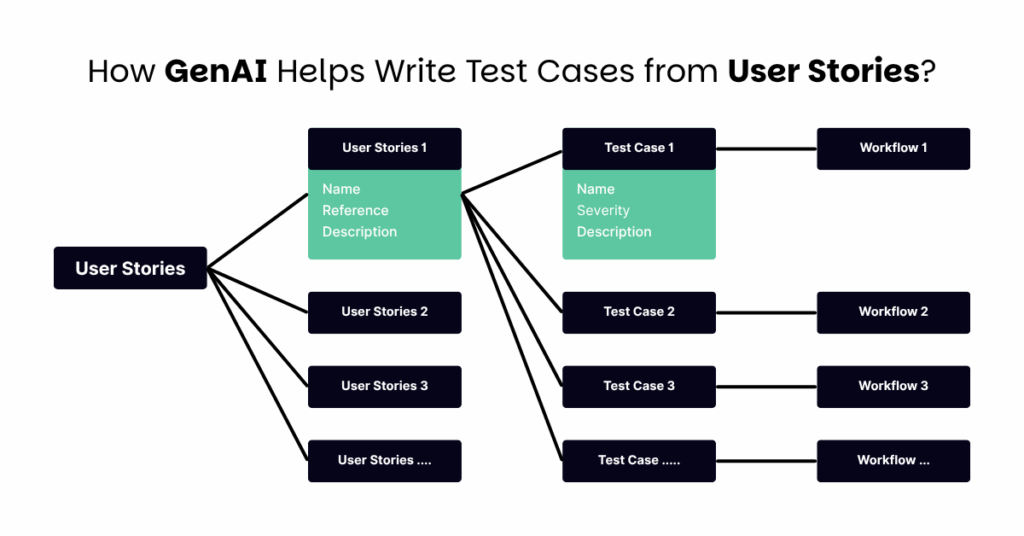
When you work with user stories, you already have a clear description of the desired behavior and acceptance criteria. Generative AI (GenAI) uses advanced Natural Language Processing (NLP) to understand these stories and automatically generate test cases based on them. This can help streamline your test design and reduce manual effort.
Why User Stories Are a Great Input for GenAI
User stories are a natural fit for GenAI because they clearly outline what the system should do from a user’s perspective. They often include acceptance criteria, which describe specific conditions for success or failure. Since the stories already capture the expected behavior, GenAI can efficiently analyze them and create relevant test scenarios without needing additional context.
How GenAI Processes User Stories
Here’s how the process typically works:
- The AI reads through the user story and any acceptance criteria.
- It identifies key actions, inputs, and expected outcomes within the text.
- It detects different types of scenarios, including positive flows, negative cases, and boundary conditions.
- Finally, it organizes these scenarios into clear, structured test steps that you can review and use.
Example of User Story to Test Case Conversion
Consider this user story:
As a registered user, I want to reset my password so that I can regain access if I forget it.
From this, GenAI might generate test cases such as:
- Verify the presence of a “Forgot Password” link on the login page.
- Verify that submitting a registered email address sends a password reset link.
- Verify that the reset link directs to the password reset page.
- Verify that the user cannot reuse a previous password.
- Verify that entering an unregistered email address shows an appropriate error message.
This example shows how GenAI can translate a simple user story into a comprehensive set of test cases, helping you save time and ensure good coverage.
Use Cases of GenAI in Test Case Authoring
Generative AI (GenAI) can help you create test cases from a variety of inputs, making it easier to cover all bases without spending excessive time on manual writing. Below are some practical examples of how GenAI can be applied to different sources of requirements and artifacts.
User Story to Test Case
When you provide user stories or acceptance criteria, GenAI can analyze the text and generate detailed test cases for you. These test cases often cover functional scenarios, boundary conditions, and negative paths, helping ensure your tests are thorough and aligned with expected behavior. This approach saves time and helps maintain consistent coverage across your software testing efforts.
Image to Test Case
If you work with UI mockups, wireframes, or screenshots, GenAI tools can analyze these images to generate relevant test cases. By uploading annotated images of screens, you can receive suggested tests that verify fields, buttons, error messages, layout elements, and more. This capability is especially valuable when working with early design prototypes, allowing you to start validating user interface requirements before the system is fully built.
JIRA to Test Case
Many teams use issue tracking tools like JIRA to manage their requirements and user stories. GenAI can integrate with these tools to extract the relevant information directly from JIRA tickets and automatically generate corresponding test cases. This not only saves manual effort but also helps keep test documentation closely tied to your development and issue workflows.
Benefits of Using GenAI for Test Case Authoring
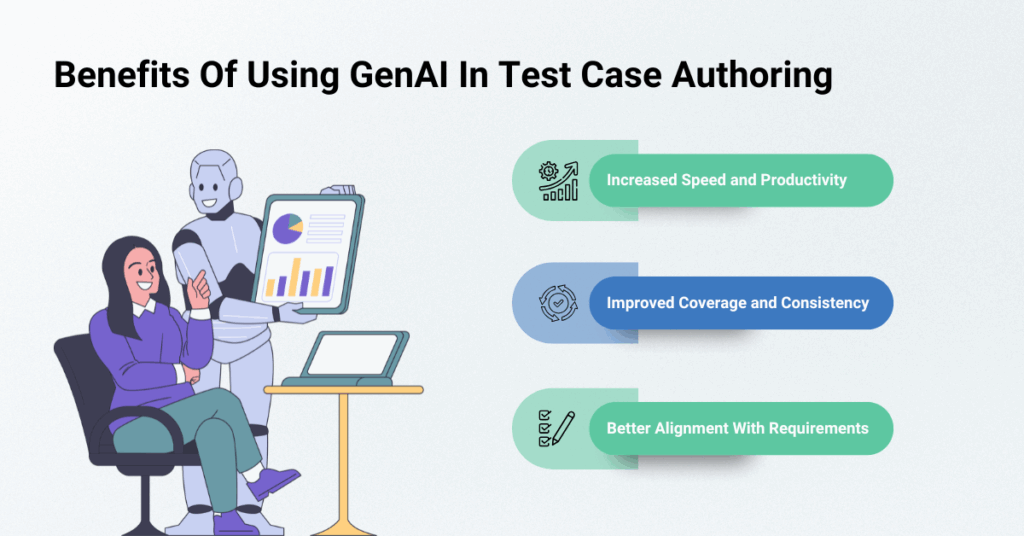
When you incorporate Generative AI into your test case authoring process, you open the door to several significant advantages that can help your QA team work smarter and more efficiently.
Increased Speed and Productivity
One of the most immediate benefits you’ll notice is the significant reduction in time needed to create test cases. Instead of manually analyzing requirements and writing every scenario from scratch, GenAI automates much of this work, allowing you to generate detailed test cases quickly and focus your energy on executing tests and exploring the application.
Improved Coverage and Consistency
GenAI helps make sure no critical scenarios slip through the cracks. By analyzing user stories, images, or tickets thoroughly, it identifies positive, negative, and boundary conditions that might be overlooked otherwise. Additionally, the AI maintains a consistent format and structure across your test cases, which enhances readability and simplifies test management.
Better Alignment With Requirements
Because GenAI generates test cases directly from the inputs you provide, such as user stories or specifications, the resulting tests align closely with the intended functionality. This helps reduce gaps between what is expected and what is tested, increasing confidence that your tests are covering the right areas.
Why GenAI Matters for Test Case Authoring
GenAI is becoming an essential tool in QA because it helps accelerate the test design process, enabling you to produce comprehensive test cases faster than ever before.
By automatically considering a wider range of scenarios, including edge cases and negative flows, GenAI enhances your test coverage, thereby reducing the likelihood of missing critical issues. At the same time, it maintains consistency in your test documentation, making it easier for you and your team to manage and maintain test cases over time.
Most importantly, GenAI frees you from spending hours on routine and repetitive test case writing. This shift enables you to focus your skills and energy on higher-value activities, such as exploratory testing and creative problem-solving, where your insights truly make a difference in delivering quality software.
Challenges and Considerations
While Generative AI offers many benefits, it’s important to keep in mind some challenges and considerations to use it effectively in your test case authoring process.
Quality of Input Data Matters
The accuracy and usefulness of AI-generated test cases depend heavily on the quality of the inputs you provide. If user stories are vague, incomplete, or poorly written, or if images lack necessary annotations, the resulting test cases may miss critical details or include inaccuracies. Ensuring clear and well-defined inputs helps GenAI produce more effective outputs.
The Need for Human Oversight
Although GenAI can automate much of the test case creation, it’s still essential for you and your team to review and validate the generated test cases before executing them. Human insight remains crucial for identifying gaps, adapting tests to specific contexts, and ensuring that test cases accurately reflect the requirements and business needs.
Domain-Specific Knowledge
In specialized industries or complex applications, GenAI may require additional training or customization to handle domain-specific terminology, workflows, and rules effectively. You should invest time in tuning the AI model or integrating it with your existing knowledge base to achieve the best results.
Best Practices for Using GenAI in Test Case Authoring
To get the most value from Generative AI in your test case authoring, consider the following best practices:
- Provide Clear and Detailed Inputs
Ensure your user stories, acceptance criteria, images, and JIRA tickets are well-defined and comprehensive. The clearer the input, the more accurate and useful the AI-generated test cases will be. - Review and Refine AI-Generated Test Cases
Always allocate time to review the test cases produced by GenAI. Validate them against the requirements and make any necessary adjustments to cover edge cases or business-specific conditions. - Utilize AI for Routine and Repetitive Tasks
Use GenAI primarily to handle repetitive or straightforward test case creation, freeing up your time to focus on complex exploratory testing and quality assurance activities that require human creativity. - Customize and Train the AI When Needed
If you work in a specialized domain, invest in customizing or training the AI model with domain-specific data and terminology. This improves the relevance and accuracy of the generated test cases. - Integrate GenAI with Your Existing Tools
Where possible, connect GenAI with tools you already use, such as JIRA or test management platforms, to streamline workflows and keep everything in sync. - Continuously Monitor and Improve
As you use GenAI, keep track of its outputs and gather feedback from testers. Use this information to fine-tune inputs and improve AI performance over time.
Conclusion
Generative AI is reshaping the way QA teams approach test case authoring, making it faster, more accurate, and aligned with requirements. Whether you’re working from user stories, UI mockups, or JIRA tickets, GenAI empowers testers to create high-quality test cases in less time.
QA Touch is a modern test management platform designed to simplify your testing process with seamless integration, real-time collaboration, and AI-powered features. It helps teams organize, automate, and track test cases efficiently, ensuring better quality and faster delivery. With QA Touch, you can streamline your testing workflows and stay in sync with development cycles effortlessly.
Sign up today.
FAQ
- What are the benefits of Gen AI in testing?
Gen AI helps speed up test case creation, improves test coverage by considering more scenarios, ensures consistency in documentation, and frees testers to focus on higher-value exploratory and creative testing tasks.
- How does generative AI affect software testing?
Generative AI automates routine test design by generating test cases from user stories, images, and issue trackers. This accelerates test planning, reduces manual effort, and enhances the overall quality and coverage of testing.
- Can Gen AI help generate Unit test cases?
Yes, Gen AI can assist in generating unit test cases by analyzing code snippets, requirements, or user stories and suggesting relevant tests. However, human review remains important to ensure tests align with coding standards and cover edge cases effectively.



